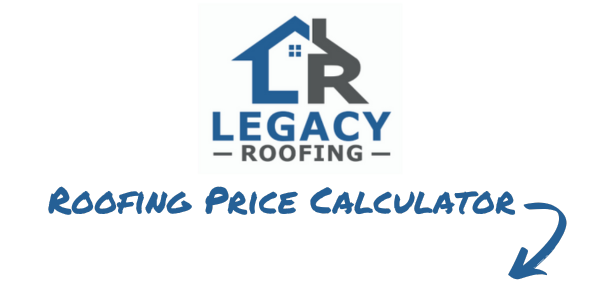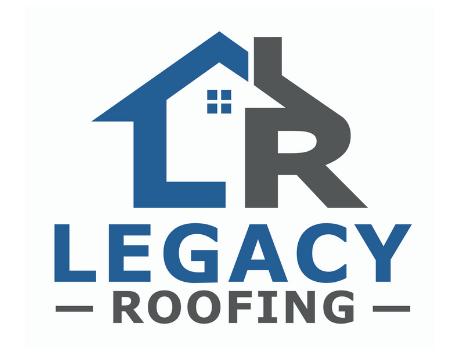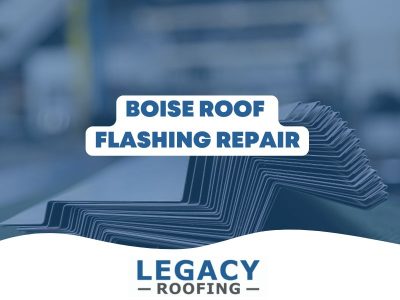Are you looking for help for a leak or need a roof flashing repair?
We can help you! Here at Legacy Roofing of Idaho, we help countless residents in the Treasure Valley with roof replacements and repairs all the time! The most common cause of a roof leak is a toss up between your roof’s flashing and a missing shingle!
Keep reading to learn how Boise roof flashing repair works, what it costs, and the signs that mean it’s time to act before your attic starts crying for help.
Quick Summary: Boise Roof Flashing Repair at a Glance
Below is a summary of this article to make it super easy to get what you need fast! Contact us here if you need a urgent roof repair or inspection!
- What flashing does: It’s the thin metal that keeps Boise rain, snowmelt, and stormwater from sneaking behind your shingles.
- Why it fails: Freeze-thaw cycles, sun exposure, and old sealant cause cracks, rust, and loosened fasteners—especially around chimneys, skylights, and walls.
- Repair options:
- Reseal when metal is solid but sealant has dried.
- Targeted repair for isolated leaks or small rust spots.
- Full replacement if corrosion or installation errors are widespread.
- Average Boise costs: From $150 for small vent fixes to $1,800 for full chimney flashing rebuilds.
- When to act: Ceiling stains, musty attic odors, or rust streaks mean water is already inside—don’t wait for the next storm.
- DIY vs. pro: Minor reseals can be safe for homeowners, but chimneys, skylights, and steep roofs demand professional tools and safety gear.
💧 Bottom line: A $300 flashing repair today can prevent a $10,000 roof replacement tomorrow.
👉 Schedule your free roof inspection today with Legacy Roofing Idaho to find out exactly what your roof needs—before a small drip becomes a major problem.
What Is Roof Flashing and Where Does It Fail Most Often?

Small flashing leak? Harmless, right? Wrong.
That drip from your ceiling might be flashing damage spreading beneath the shingles. In Boise’s freeze-thaw climate, one neglected seam can open the door to mold, rot, and ruined insulation. A quick fix today can spare you from a roof replacement tomorrow.
Flashing is the thin metal that turns water away from high-risk seams: where shingles meet chimneys, walls, skylights, valleys, and vents. It wins by controlling water flow and capillary action, even during wind-driven rain. Boise roofs see big temperature swings, winter freeze–thaw, and strong sun, so sealants dry out, metals expand, and fasteners loosen over time.
Here is where problems tend to start, and why:
- Chimneys: Step flashing and counterflashing separate. Mortar joints crack, sealant dries, and water tracks behind the bricks.
- Sidewalls and headwalls: Step flashing slips when nails back out or when siding work disturbs the laps.
- Valleys: Debris traps water, coatings wear thin, and small punctures create long hidden leaks.
- Skylights: Old kits lose their gaskets. Standing water sneaks beneath worn apron or saddle pieces.
- Pipe boots and vents: UV brittles rubber collars. Metal edges corrode where paint chips.
- Mixed metals: Copper near bare steel invites galvanic corrosion and early rust.
A small gap at any of these spots can move a lot of water. Early attention costs less than ceiling stains and soggy insulation.
Do You Need Repair, Reseal, or Full Replacement?
Choosing the fix is about condition and cause, not guesswork. We look at the metal, the laps, the shingle tie-in, and the deck beneath. If the metal is sound and the leak is from dried sealant, a reseal is reasonable. If pieces are bent, missing, or installed out of sequence, we replace sections. If corrosion is widespread or the detail was never built correctly, the right move is a full rebuild of the flashing assembly.
Here is a quick way to match the solution to the problem:
1. When a Reseal Is Enough

The exterior of your home can be tricky to diagnose when there is an issue, but the fix? Well that can be even trickier! Think of reseal work as tune-ups for otherwise healthy metal.
- Good candidates: Hairline cracks at laps, minor pinholes, or dried counterflashing joints with solid step flashing beneath.
- What we do: Clean the surface, remove brittle compound, set backer where gaps are wide, and apply compatible sealant for the metal and shingles.
- What to expect: One to three years of added service in Boise weather when the area drains well and the roof field is in good shape.
2. When a Targeted Repair Makes Sense
Use a surgical fix when the failure is confined to a small zone.
- Good candidates: A few slipped step flashings at a dormer, a split pipe boot, a short rusted section at a valley, or metal deformed by past ice.
- What we do: Lift shingles around the damage, replace the affected metal course by course, add ice-and-water membrane as needed, re-tie the shingles, and seal fasteners correctly.
- What to expect: A durable fix that matches the remaining roof life without paying for a full tear-out.
3. When Full Flashing Replacement Is the Right Call
Rebuild the detail when the system has failed, not just the sealant.
- Good candidates: Chimneys with loose step and counterflashing together, valleys with broad corrosion, repeated leaks at a wall line, or flashing installed out of sequence during original construction.
- What we do: Remove surrounding shingles, install fresh underlayment, rebuild step flashing course by course, cut and set new counterflashing into a reglet or mortar joint, seal with the right compound, then water-test the assembly.
- What to expect: Long-term performance and cleaner lines. If shingles are near end of life, pairing this with re-roofing can save labor and prevent future tear-backs.
Boise Roof Flashing Repair Costs
Boise pricing follows the same rule as water: it finds the easiest path. Access, pitch, and damage depth steer the final number. Here is what most homeowners want first, a clear view of typical costs and what changes them.
Typical Price Ranges in Boise
These amounts are approximate and for planning only. For a tighter estimate based on your roof size, pitch, and access, use the roof price calculator on our website.
| Service Scope | What It Includes | Typical Cost (USD) |
|---|---|---|
| Pipe boot or small vent flashing repair | Replace boot or small metal, reseal, fasteners, localized shingles | $150 to $350 |
| Step flashing tune-up at a wall or dormer | Lift a few shingles, reset or swap several step pieces, reseal | $300 to $750 |
| Valley flashing repair or partial replacement | Remove debris, patch or replace section, underlayment tie-in | $600 to $1,500 |
| Skylight flashing kit replacement | New kit, integration with shingles, perimeter seal | $500 to $1,200 |
| Chimney step and counterflashing rebuild | New step courses, reglet or mortar cut, counterflashing, seal | $700 to $1,800 |
What Drives Price Up or Down
Before we list the variables, a quick roadmap will keep the details organized and useful.
- Access and height: Steeper pitches, multiple stories, or tight lots increase labor and safety setup.
- Scope creep: Hidden rot, saturated insulation, or damaged decking adds time and materials.
- Material choice: Galvanized steel, aluminum, or copper each carry different costs and lifespans.
- Weather and timing: Cold or wet conditions slow sealant cure and extend labor hours.
- Adjacent work: Siding touches, masonry fixes, or skylight swaps expand the scope.

How to Budget Smartly
Smart planning beats surprise spending. Use these quick rules of thumb to keep control.
- Bundle small items: Combine minor leaks in one visit to save on setup and travel.
- Hold a contingency: Set aside 10 to 20 percent for hidden damage discovered under shingles.
- Match lifespan: If shingles are near end of life, plan flashing work with re-roofing to avoid future tear-backs.
- Document everything: Photos and notes help with insurance when wind or storm events are involved.
Signs You Need Flashing Repair Now
You usually don’t get a warning before flashing starts leaking, it begins quietly. A small water stain or a musty smell in the attic might not seem urgent, but in Boise’s freeze-thaw climate, one hidden drip can turn into soaked insulation, warped decking, and mold in a matter of weeks. Catching these signs early saves you from costly repairs later.
Inside Your Home
Start indoors. Most flashing leaks reveal themselves here first:
- Ceiling stains or peeling paint near chimneys and skylights. These often appear after a hard rain or snowmelt and mean moisture is working its way down from the roofline.
- A musty smell or damp insulation in the attic. After a Boise winter thaw, even a small gap in flashing can let enough moisture in to start mildew growth.
- Light shining through roof penetrations. If you can see daylight around vents or along wall lines in the attic, that’s a clear path for water too.
If you notice any of these, don’t wait for it to “get worse.” It already has—just behind the drywall.
Outside Your Roof
From the ground, you can spot many issues before they become interior damage:
- Loose shingles or cracked sealant where your roof meets walls or dormers. This is a common failure point after strong Treasure Valley windstorms.
- Rust streaks or missing metal around chimneys, valleys, and skylights. Boise’s sun and snow cycle can eat away at flashing faster than you’d think.
- Split or brittle pipe boots. UV rays dry out the rubber collars that seal plumbing vents, allowing water to run straight into the decking below.
If you’re unsure, grab a pair of binoculars after a storm and take a slow look along your rooflines—or give us a call and we’ll take a closer look safely from above.
👉 Chuck’s Tip: If you notice stains, rust, or loose sealant, don’t wait for the next Boise storm to test your luck. Schedule a quick roof inspection with Legacy Roofing Idaho and we’ll let you know exactly what your roof needs, no pressure, just honest advice from a local team that’s seen every type of leak Idaho weather can throw at a home.
What Happens During a Professional Flashing Repair?

Good flashing repair is part detective work, part surgery. The goal is simple: stop the leak at its source, rebuild the water pathway, and leave the roof looking like nothing ever happened. Here is how a proper visit unfolds from first look to final photo.
1. Assessment and Prep
We start with moisture readings, attic checks, and a close look at the suspect detail. A few shingles are lifted to inspect the deck and underlayment. Metal type and condition are confirmed, mortar joints are checked, and the slope and drainage are mapped. Safety gear goes up, surfaces are cleaned, and the work area is protected.
2. Repair or Replacement Work
Minor failures get removed sealant, cleaned laps, backer where gaps are wide, and a compatible sealant applied. Localized damage means lifting courses, replacing step flashing piece by piece, tying in ice and water membrane, and resetting shingles with correct fasteners. Full failures call for a rebuild: fresh underlayment, new step flashing in sequence, counterflashing cut into a reglet or mortar joint, and tight integration at valleys or skylights.
3. Sealing and Water Testing
Joints are sealed with the right chemistry for the metal and roof system. Laps are set to shed water, not hold it. After initial cure, a hose test begins low and works upward while one tech watches the interior. If the area stays dry, the repair is cleared.
4. Cleanup and Warranty
Debris is bagged, nails are magnet-swept, and the site is left clean. You receive photo documentation, care notes, and warranty terms. We outline simple maintenance so the repair lasts: seasonal checks, clear gutters, and prompt attention to fresh sealant wear.
5. DIY vs Professional Flashing Repair
Flashing looks like simple metal, yet it is precision plumbing for your roof. One wrong overlap and water takes the scenic route into your attic. The smart path is to match the task to the risk, then choose tools and talent accordingly.
Here is a quick, low-risk starting point before you reach for bigger fixes:
- Small reseals on sound metal: Clean, dry, and reapply compatible sealant at short, hairline gaps.
- Pipe boot collars on low pitch roofs: Swap a brittle rubber collar if the base and shingles are intact.
- Debris control at valleys and walls: Clear leaves and grit that hold water against metal.
Keep it simple, work on dry days, and photograph before and after for your records.
The professionalism and responsive care were without flaw. Anytime I had a question I would leave a text or message and I would get prompt responses.
My roof looks beautiful and I got the exact color of roof shingle I wanted.
I would without reservation recommend this company to anyone wanting to get their roof replaced.
When to Call a Pro Roofer to Help:
Do you know when to call a local Boise area roofer to help you with your roof’s flashing? If not, that is ok, we can help by walking you through the steps below! Remember, the moment a repair involves hidden layers or hot-zone details, it is time for experienced hands:
- Chimneys, skylights, and long wall lines: These require step flashing in sequence and counterflashing set into masonry or factory kits.
- Widespread rust or slipped courses: Sections must be lifted, underlayment patched, and metal replaced piece by piece.
- Steep pitch, multi-story access, or winter work: Safety systems, staging, and cold-rated products are required.
Professionals bring proper laps, correct fasteners, and integration with underlayment so water sheds, not pools.
Safety and Warranty Considerations
| Factor | DIY Risk Level | Pro Advantage | Why It Matters |
|---|---|---|---|
| Fall protection | High on steep or tall roofs | Proper anchors, ladders, and tie-offs | Prevents injuries and liability headaches |
| Product compatibility | Medium | Correct sealants and metals matched to the roof | Avoids chemical reactions and premature failure |
| Proper laps and sequence | Medium to high | Trained installation order for step and counterflashing | Stops capillary leaks that hide for months |
| Code and manufacturer specs | Medium | Work to local code and manufacturer details | Keeps shingle and flashing warranties valid |
| Documentation | Low | Photo sets and written scope | Supports warranty service and insurance claims |
A few things to keep decisions crystal clear:
- Choose DIY for short, simple reseals on accessible, low pitch areas.
- Choose pro service for any chimney, skylight, long wall, or valley rebuild.
- Save all photos and invoices. Warranties care about proof.
Do the easy, visible maintenance yourself. Hand off anything layered, high, or structural. That split-second decision is usually cheaper than undoing a well-intended fix.
The Final Word on Roof Flashing
By now you know when you have a roof flashing issue or leak that needs attention. You also know what to do! When your roof’s flashing is compromised, be ready to make it better with the pros at Legacy Roofing of Idaho!
If you see stains, rust, or loose sealant, don’t wait for the next storm to test your luck. Contact us for a quick, no-pressure inspection and find out what your roof really needs before it starts telling you in buckets.


 8 Signs You Need New Windows in Boise
8 Signs You Need New Windows in Boise